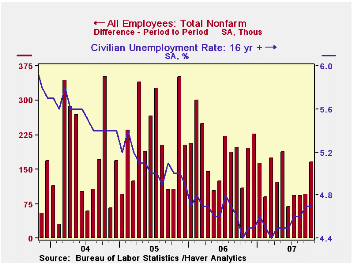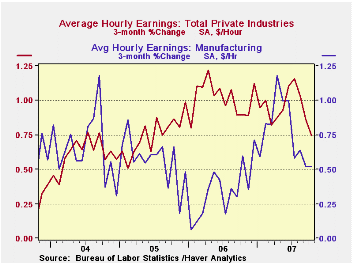 Global| Nov 02 2007
Global| Nov 02 2007U.S. Payrolls Rose Double Expectations
by:Tom Moeller
|in:Economy in Brief
Summary
Nonfarm payrolls increased 166,000 last month. The gain was double the rise expected by the consensus of economists, although the increase in September jobs was revised slightly downward to 96,000 from the 110,000 reported last month. [...]

Nonfarm payrolls increased 166,000 last month. The gain was double the rise expected by the consensus of economists, although the increase in September jobs was revised slightly downward to 96,000 from the 110,000 reported last month.
An increase in private service sector jobs in October added nearly all of the heft to last month's job gain. The increase of 154,000 was provided by a 65,000 (2.1% y/y) rise in professional & business service jobs and a 7,500 (3.1% y/y) rise in jobs in the education sector. Additionally, 35,100 (3.2% y/y) jobs were added in the health care sector and the leisure industry added 56,000 (3.3% y/y) workers. These gains offset weak or negative growth elsewhere in service sector jobs.
In what is perhaps a positive sign for future growth in jobs, employment in the temporary help industry rose 20,200 (-1.6% y/y) and offset all of the prior month's decline.
Employment in the government sector also rose a respectable 36,000 (1.0% y/y).
Factory sector payrolls fell another 21,000, adding to a decline that began early last year. Again, these declines are at odds with the recent ISM reports of job growth in manufacturing. Construction employment fell by 5,000 last month after a 14,000 worker decline during September.
Average hourly earnings increased 0.2% and the prior month's gain was revised down slightly. Factory sector earnings rose 0.1% (2.9% y/y) and private service-providing earnings rose 0.2% (3.9% y/y).
The unemployment rate held steady at 4.7% last month. Household employment fell 250,000 (+0.5% y/y) and offset about half of the prior month's surge while the labor force fell 211,000 (+1.8% y/y) after jumping 573,000 in September. The labor force participation rate fell slightly to 65.9% and that was down from 66.2% during all of last year.
| Employment : 000s | October | September | August | Y/Y | 2006 | 2005 | 2004 |
|---|---|---|---|---|---|---|---|
| Payroll Employment | 166 | 96 | 93 | 1.2% | 1.9% | 1.7% | 1.1% |
| Previous | -- | 110 | 93 | -- | -- | -- | -- |
| Manufacturing | -21 | -17 | -45 | -1.4% | -0.2% | -0.6% | -1.3% |
| Construction | -5 | -14 | -29 | -1.4% | 4.8% | 5.2% | 3.6% |
| Average Weekly Hours | 33.8 | 33.8 | 33.8 | 33.9 (Oct '06) | 33.8 | 33.8 | 33.7 |
| Average Hourly Earnings | 0.2% | 0.3% | 0.3% | 3.8% | 3.9% | 2.8% | 2.1% |
| Unemployment Rate | 4.7% | 4.7% | 4.6% | 4.4% (Oct '06) | 4.6% | 5.1% | 5.5% |
Tom Moeller
AuthorMore in Author Profile »Prior to joining Haver Analytics in 2000, Mr. Moeller worked as the Economist at Chancellor Capital Management from 1985 to 1999. There, he developed comprehensive economic forecasts and interpreted economic data for equity and fixed income portfolio managers. Also at Chancellor, Mr. Moeller worked as an equity analyst and was responsible for researching and rating companies in the economically sensitive automobile and housing industries for investment in Chancellor’s equity portfolio. Prior to joining Chancellor, Mr. Moeller was an Economist at Citibank from 1979 to 1984. He also analyzed pricing behavior in the metals industry for the Council on Wage and Price Stability in Washington, D.C. In 1999, Mr. Moeller received the award for most accurate forecast from the Forecasters' Club of New York. From 1990 to 1992 he was President of the New York Association for Business Economists. Mr. Moeller earned an M.B.A. in Finance from Fordham University, where he graduated in 1987. He holds a Bachelor of Arts in Economics from George Washington University.






